Review of Concentrated Solar Power (CSP) Technology and Systems
VerifiedAdded on 2022/11/16
|19
|4534
|472
Report
AI Summary
This report provides a comprehensive review of concentrated solar power (CSP) technology, focusing on its applications and current status, particularly within the United States. The introduction highlights the significance of low-carbon power and traces the historical development of CSP. The report delves into the mechanics of CSP systems, exploring the dominant technologies such as parabolic trough, power tower, parabolic dish, and linear Fresnel systems, along with their advantages, disadvantages, and collector technologies. It also examines storage technologies and emerging innovations. Furthermore, it assesses the impact of CSP on energy systems, other fuels, and the environment, while also identifying barriers like siting and market entry challenges and opportunities. The report concludes by summarizing the key findings and emphasizing the growing importance of CSP in the global move towards a low-carbon economy, particularly in the US.
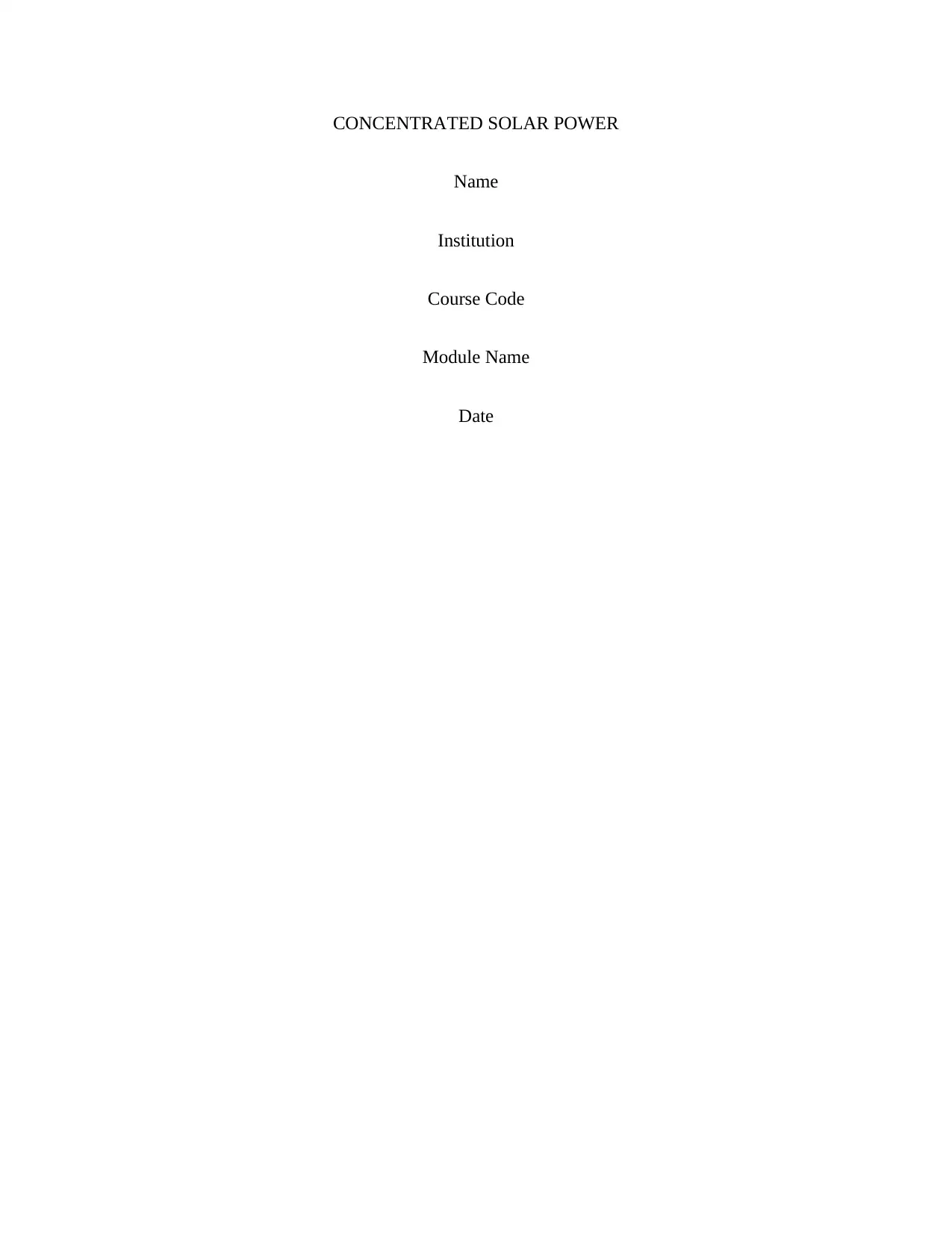
CONCENTRATED SOLAR POWER
Name
Institution
Course Code
Module Name
Date
Name
Institution
Course Code
Module Name
Date
Paraphrase This Document
Need a fresh take? Get an instant paraphrase of this document with our AI Paraphraser
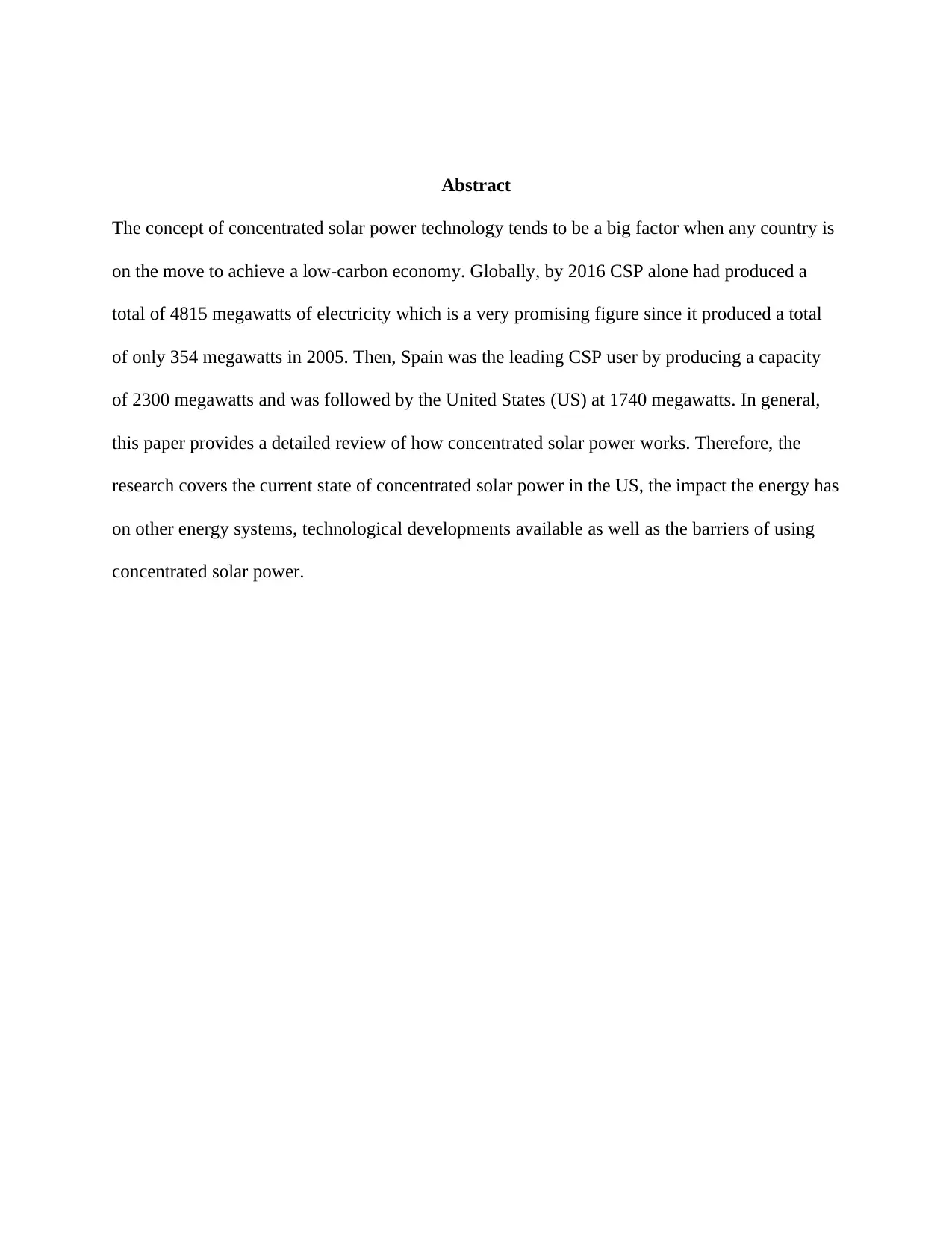
Abstract
The concept of concentrated solar power technology tends to be a big factor when any country is
on the move to achieve a low-carbon economy. Globally, by 2016 CSP alone had produced a
total of 4815 megawatts of electricity which is a very promising figure since it produced a total
of only 354 megawatts in 2005. Then, Spain was the leading CSP user by producing a capacity
of 2300 megawatts and was followed by the United States (US) at 1740 megawatts. In general,
this paper provides a detailed review of how concentrated solar power works. Therefore, the
research covers the current state of concentrated solar power in the US, the impact the energy has
on other energy systems, technological developments available as well as the barriers of using
concentrated solar power.
The concept of concentrated solar power technology tends to be a big factor when any country is
on the move to achieve a low-carbon economy. Globally, by 2016 CSP alone had produced a
total of 4815 megawatts of electricity which is a very promising figure since it produced a total
of only 354 megawatts in 2005. Then, Spain was the leading CSP user by producing a capacity
of 2300 megawatts and was followed by the United States (US) at 1740 megawatts. In general,
this paper provides a detailed review of how concentrated solar power works. Therefore, the
research covers the current state of concentrated solar power in the US, the impact the energy has
on other energy systems, technological developments available as well as the barriers of using
concentrated solar power.
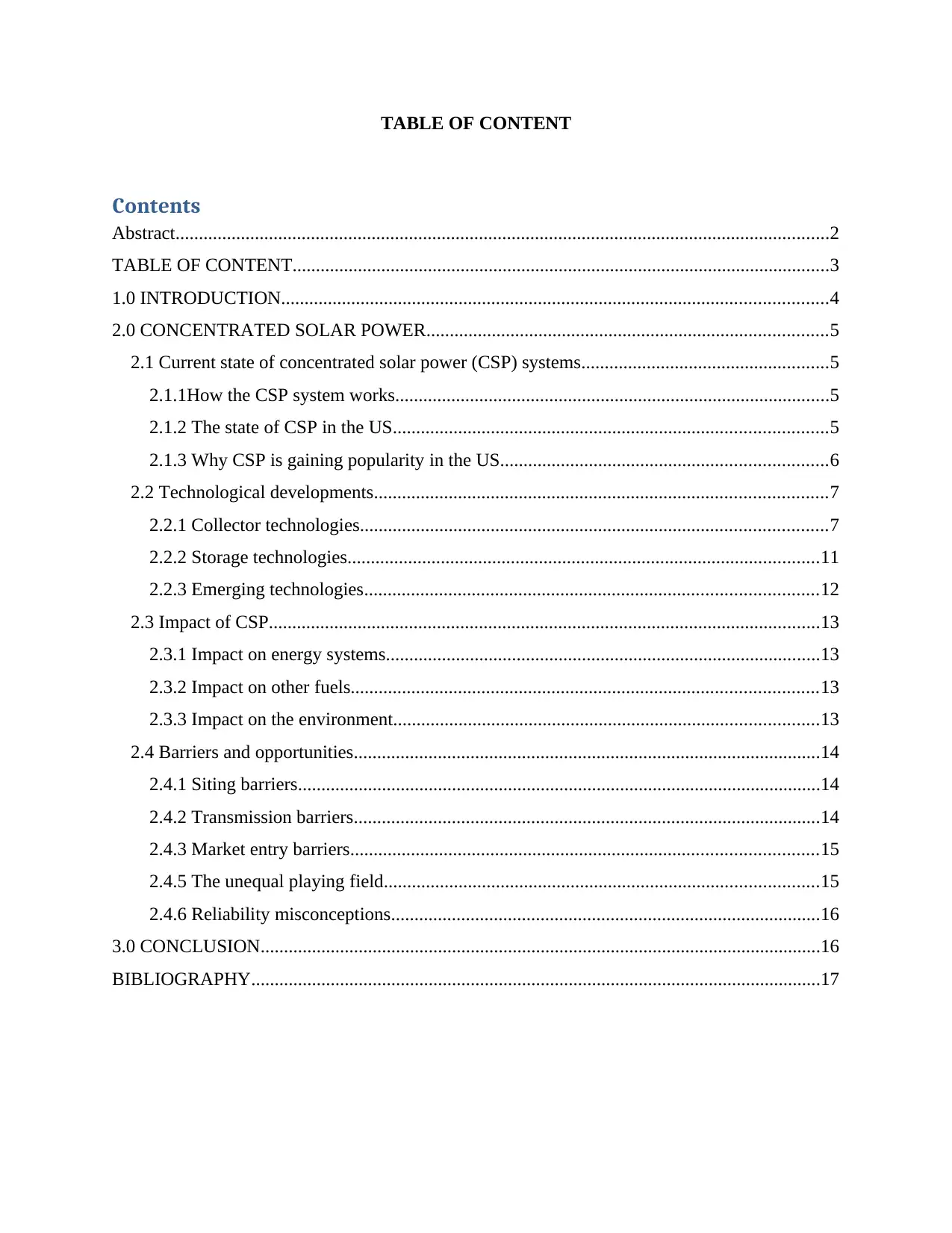
TABLE OF CONTENT
Contents
Abstract............................................................................................................................................2
TABLE OF CONTENT...................................................................................................................3
1.0 INTRODUCTION.....................................................................................................................4
2.0 CONCENTRATED SOLAR POWER......................................................................................5
2.1 Current state of concentrated solar power (CSP) systems.....................................................5
2.1.1How the CSP system works.............................................................................................5
2.1.2 The state of CSP in the US.............................................................................................5
2.1.3 Why CSP is gaining popularity in the US......................................................................6
2.2 Technological developments.................................................................................................7
2.2.1 Collector technologies....................................................................................................7
2.2.2 Storage technologies.....................................................................................................11
2.2.3 Emerging technologies.................................................................................................12
2.3 Impact of CSP......................................................................................................................13
2.3.1 Impact on energy systems.............................................................................................13
2.3.2 Impact on other fuels....................................................................................................13
2.3.3 Impact on the environment...........................................................................................13
2.4 Barriers and opportunities....................................................................................................14
2.4.1 Siting barriers................................................................................................................14
2.4.2 Transmission barriers....................................................................................................14
2.4.3 Market entry barriers....................................................................................................15
2.4.5 The unequal playing field.............................................................................................15
2.4.6 Reliability misconceptions............................................................................................16
3.0 CONCLUSION........................................................................................................................16
BIBLIOGRAPHY..........................................................................................................................17
Contents
Abstract............................................................................................................................................2
TABLE OF CONTENT...................................................................................................................3
1.0 INTRODUCTION.....................................................................................................................4
2.0 CONCENTRATED SOLAR POWER......................................................................................5
2.1 Current state of concentrated solar power (CSP) systems.....................................................5
2.1.1How the CSP system works.............................................................................................5
2.1.2 The state of CSP in the US.............................................................................................5
2.1.3 Why CSP is gaining popularity in the US......................................................................6
2.2 Technological developments.................................................................................................7
2.2.1 Collector technologies....................................................................................................7
2.2.2 Storage technologies.....................................................................................................11
2.2.3 Emerging technologies.................................................................................................12
2.3 Impact of CSP......................................................................................................................13
2.3.1 Impact on energy systems.............................................................................................13
2.3.2 Impact on other fuels....................................................................................................13
2.3.3 Impact on the environment...........................................................................................13
2.4 Barriers and opportunities....................................................................................................14
2.4.1 Siting barriers................................................................................................................14
2.4.2 Transmission barriers....................................................................................................14
2.4.3 Market entry barriers....................................................................................................15
2.4.5 The unequal playing field.............................................................................................15
2.4.6 Reliability misconceptions............................................................................................16
3.0 CONCLUSION........................................................................................................................16
BIBLIOGRAPHY..........................................................................................................................17
⊘ This is a preview!⊘
Do you want full access?
Subscribe today to unlock all pages.

Trusted by 1+ million students worldwide
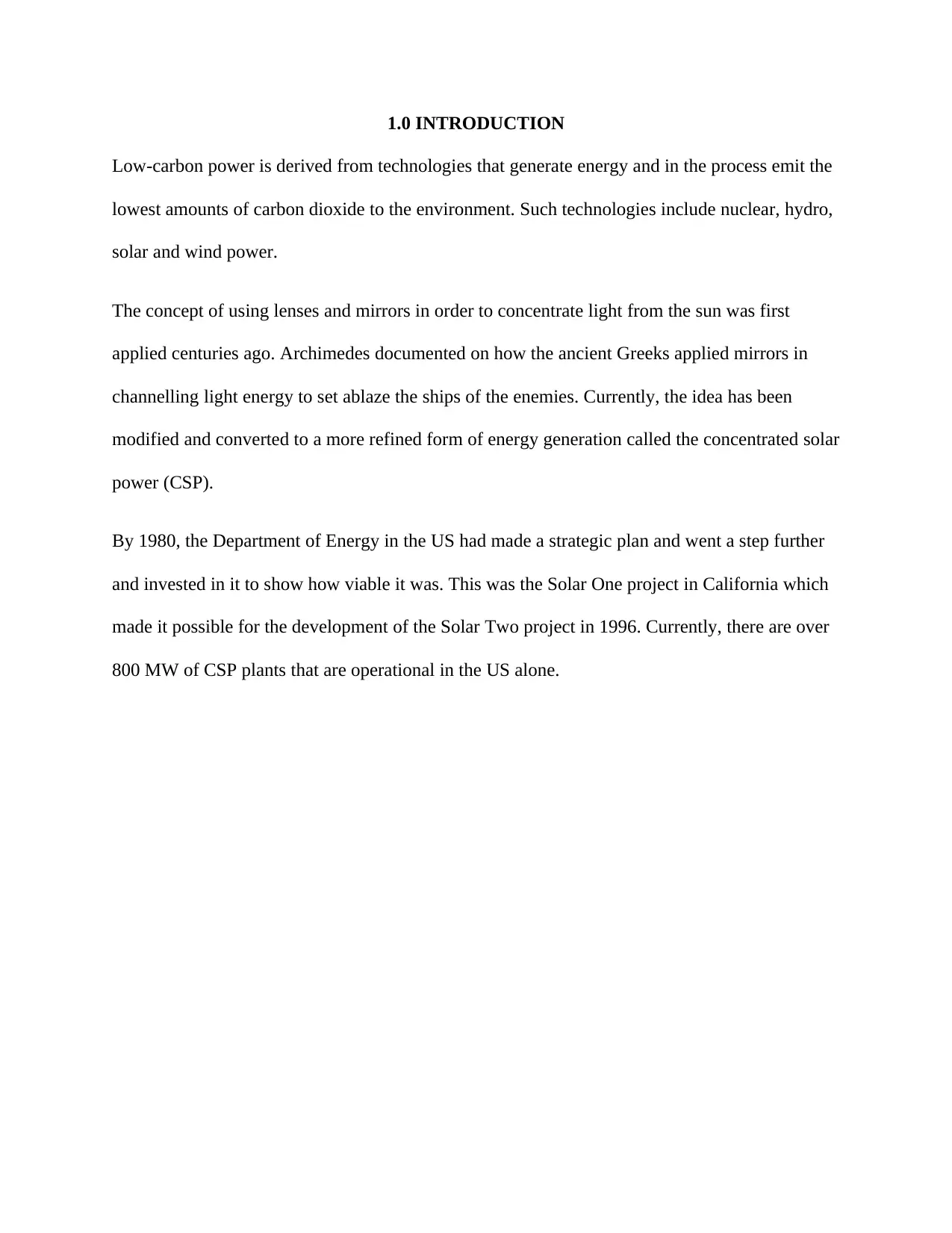
1.0 INTRODUCTION
Low-carbon power is derived from technologies that generate energy and in the process emit the
lowest amounts of carbon dioxide to the environment. Such technologies include nuclear, hydro,
solar and wind power.
The concept of using lenses and mirrors in order to concentrate light from the sun was first
applied centuries ago. Archimedes documented on how the ancient Greeks applied mirrors in
channelling light energy to set ablaze the ships of the enemies. Currently, the idea has been
modified and converted to a more refined form of energy generation called the concentrated solar
power (CSP).
By 1980, the Department of Energy in the US had made a strategic plan and went a step further
and invested in it to show how viable it was. This was the Solar One project in California which
made it possible for the development of the Solar Two project in 1996. Currently, there are over
800 MW of CSP plants that are operational in the US alone.
Low-carbon power is derived from technologies that generate energy and in the process emit the
lowest amounts of carbon dioxide to the environment. Such technologies include nuclear, hydro,
solar and wind power.
The concept of using lenses and mirrors in order to concentrate light from the sun was first
applied centuries ago. Archimedes documented on how the ancient Greeks applied mirrors in
channelling light energy to set ablaze the ships of the enemies. Currently, the idea has been
modified and converted to a more refined form of energy generation called the concentrated solar
power (CSP).
By 1980, the Department of Energy in the US had made a strategic plan and went a step further
and invested in it to show how viable it was. This was the Solar One project in California which
made it possible for the development of the Solar Two project in 1996. Currently, there are over
800 MW of CSP plants that are operational in the US alone.
Paraphrase This Document
Need a fresh take? Get an instant paraphrase of this document with our AI Paraphraser
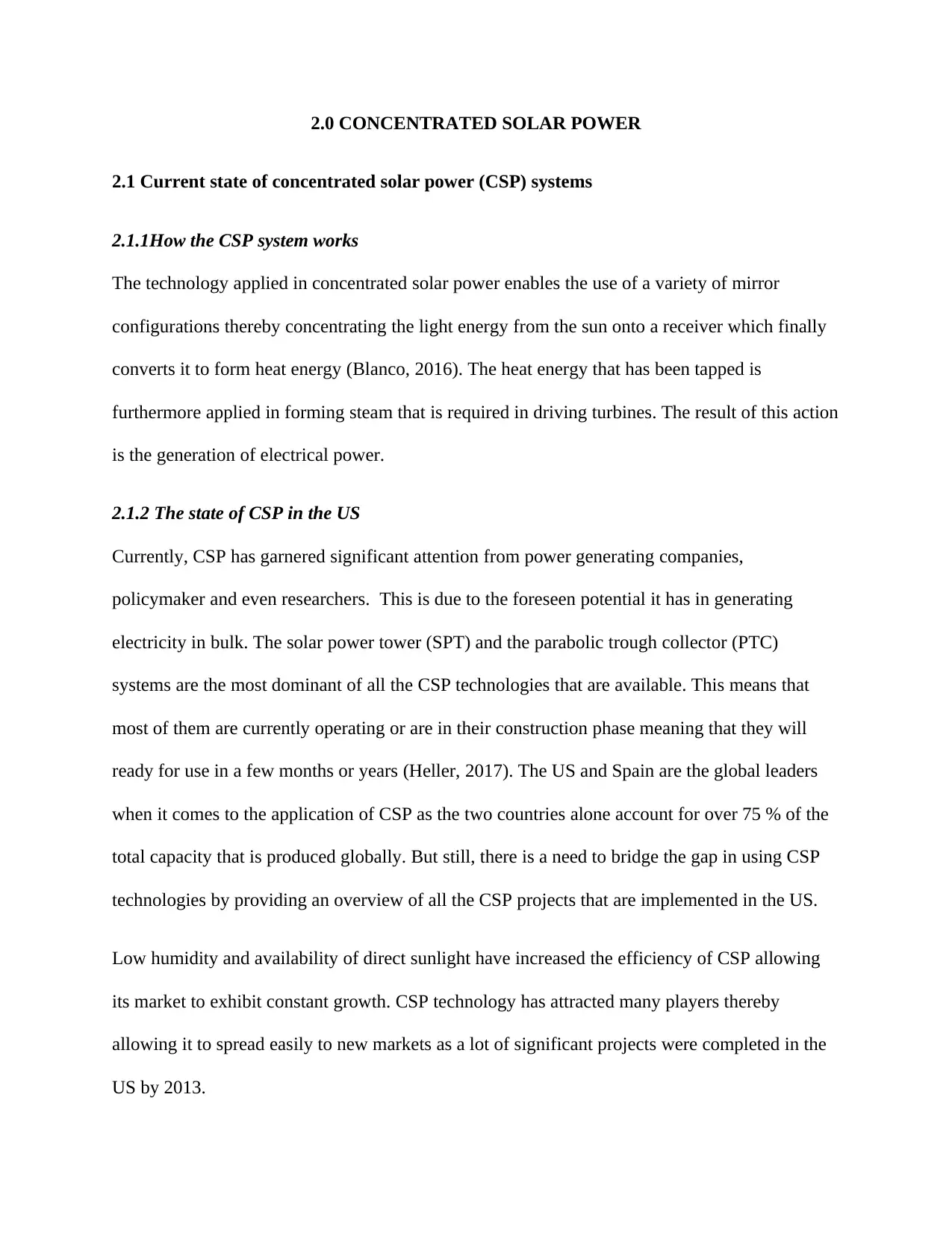
2.0 CONCENTRATED SOLAR POWER
2.1 Current state of concentrated solar power (CSP) systems
2.1.1How the CSP system works
The technology applied in concentrated solar power enables the use of a variety of mirror
configurations thereby concentrating the light energy from the sun onto a receiver which finally
converts it to form heat energy (Blanco, 2016). The heat energy that has been tapped is
furthermore applied in forming steam that is required in driving turbines. The result of this action
is the generation of electrical power.
2.1.2 The state of CSP in the US
Currently, CSP has garnered significant attention from power generating companies,
policymaker and even researchers. This is due to the foreseen potential it has in generating
electricity in bulk. The solar power tower (SPT) and the parabolic trough collector (PTC)
systems are the most dominant of all the CSP technologies that are available. This means that
most of them are currently operating or are in their construction phase meaning that they will
ready for use in a few months or years (Heller, 2017). The US and Spain are the global leaders
when it comes to the application of CSP as the two countries alone account for over 75 % of the
total capacity that is produced globally. But still, there is a need to bridge the gap in using CSP
technologies by providing an overview of all the CSP projects that are implemented in the US.
Low humidity and availability of direct sunlight have increased the efficiency of CSP allowing
its market to exhibit constant growth. CSP technology has attracted many players thereby
allowing it to spread easily to new markets as a lot of significant projects were completed in the
US by 2013.
2.1 Current state of concentrated solar power (CSP) systems
2.1.1How the CSP system works
The technology applied in concentrated solar power enables the use of a variety of mirror
configurations thereby concentrating the light energy from the sun onto a receiver which finally
converts it to form heat energy (Blanco, 2016). The heat energy that has been tapped is
furthermore applied in forming steam that is required in driving turbines. The result of this action
is the generation of electrical power.
2.1.2 The state of CSP in the US
Currently, CSP has garnered significant attention from power generating companies,
policymaker and even researchers. This is due to the foreseen potential it has in generating
electricity in bulk. The solar power tower (SPT) and the parabolic trough collector (PTC)
systems are the most dominant of all the CSP technologies that are available. This means that
most of them are currently operating or are in their construction phase meaning that they will
ready for use in a few months or years (Heller, 2017). The US and Spain are the global leaders
when it comes to the application of CSP as the two countries alone account for over 75 % of the
total capacity that is produced globally. But still, there is a need to bridge the gap in using CSP
technologies by providing an overview of all the CSP projects that are implemented in the US.
Low humidity and availability of direct sunlight have increased the efficiency of CSP allowing
its market to exhibit constant growth. CSP technology has attracted many players thereby
allowing it to spread easily to new markets as a lot of significant projects were completed in the
US by 2013.
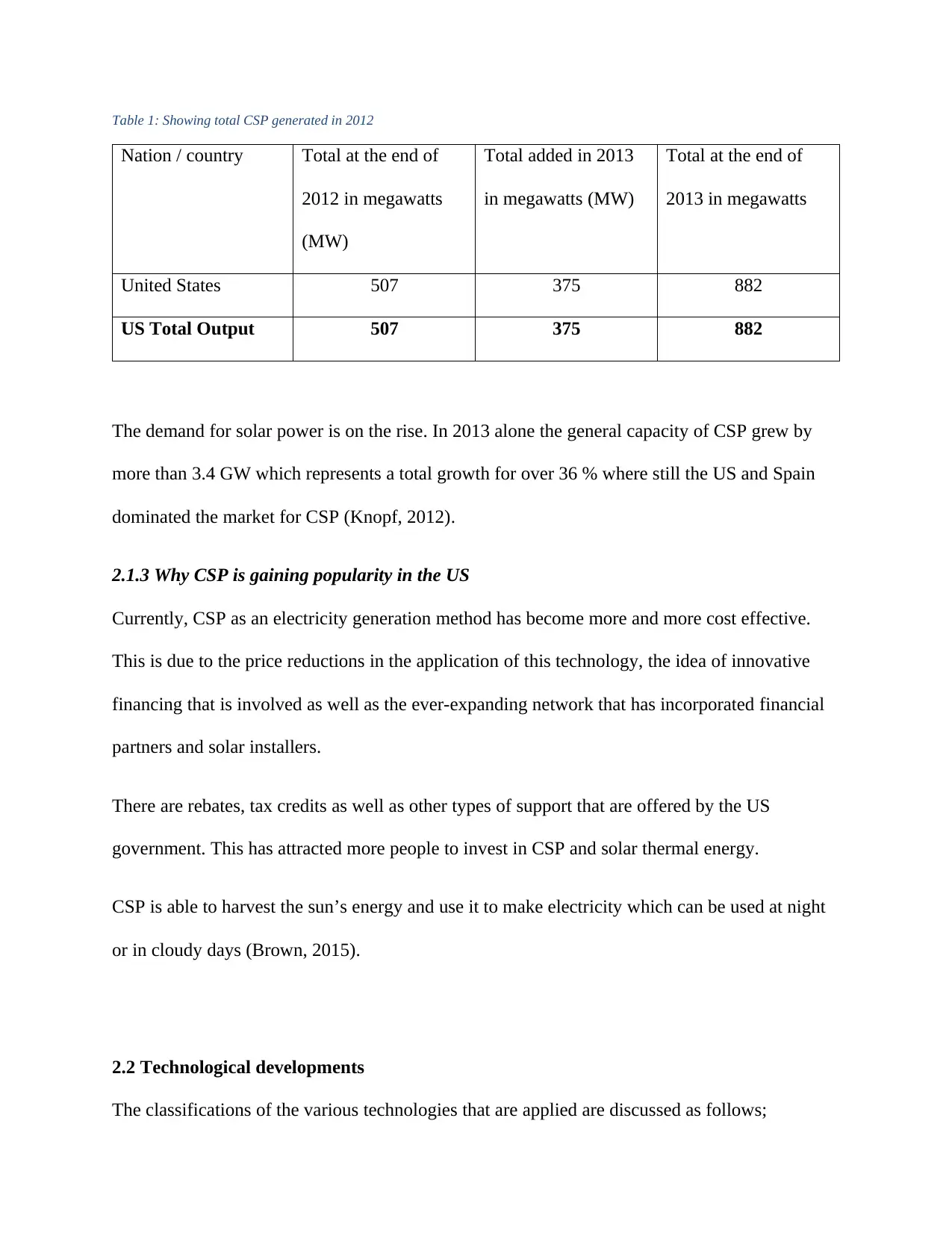
Table 1: Showing total CSP generated in 2012
Nation / country Total at the end of
2012 in megawatts
(MW)
Total added in 2013
in megawatts (MW)
Total at the end of
2013 in megawatts
United States 507 375 882
US Total Output 507 375 882
The demand for solar power is on the rise. In 2013 alone the general capacity of CSP grew by
more than 3.4 GW which represents a total growth for over 36 % where still the US and Spain
dominated the market for CSP (Knopf, 2012).
2.1.3 Why CSP is gaining popularity in the US
Currently, CSP as an electricity generation method has become more and more cost effective.
This is due to the price reductions in the application of this technology, the idea of innovative
financing that is involved as well as the ever-expanding network that has incorporated financial
partners and solar installers.
There are rebates, tax credits as well as other types of support that are offered by the US
government. This has attracted more people to invest in CSP and solar thermal energy.
CSP is able to harvest the sun’s energy and use it to make electricity which can be used at night
or in cloudy days (Brown, 2015).
2.2 Technological developments
The classifications of the various technologies that are applied are discussed as follows;
Nation / country Total at the end of
2012 in megawatts
(MW)
Total added in 2013
in megawatts (MW)
Total at the end of
2013 in megawatts
United States 507 375 882
US Total Output 507 375 882
The demand for solar power is on the rise. In 2013 alone the general capacity of CSP grew by
more than 3.4 GW which represents a total growth for over 36 % where still the US and Spain
dominated the market for CSP (Knopf, 2012).
2.1.3 Why CSP is gaining popularity in the US
Currently, CSP as an electricity generation method has become more and more cost effective.
This is due to the price reductions in the application of this technology, the idea of innovative
financing that is involved as well as the ever-expanding network that has incorporated financial
partners and solar installers.
There are rebates, tax credits as well as other types of support that are offered by the US
government. This has attracted more people to invest in CSP and solar thermal energy.
CSP is able to harvest the sun’s energy and use it to make electricity which can be used at night
or in cloudy days (Brown, 2015).
2.2 Technological developments
The classifications of the various technologies that are applied are discussed as follows;
⊘ This is a preview!⊘
Do you want full access?
Subscribe today to unlock all pages.

Trusted by 1+ million students worldwide
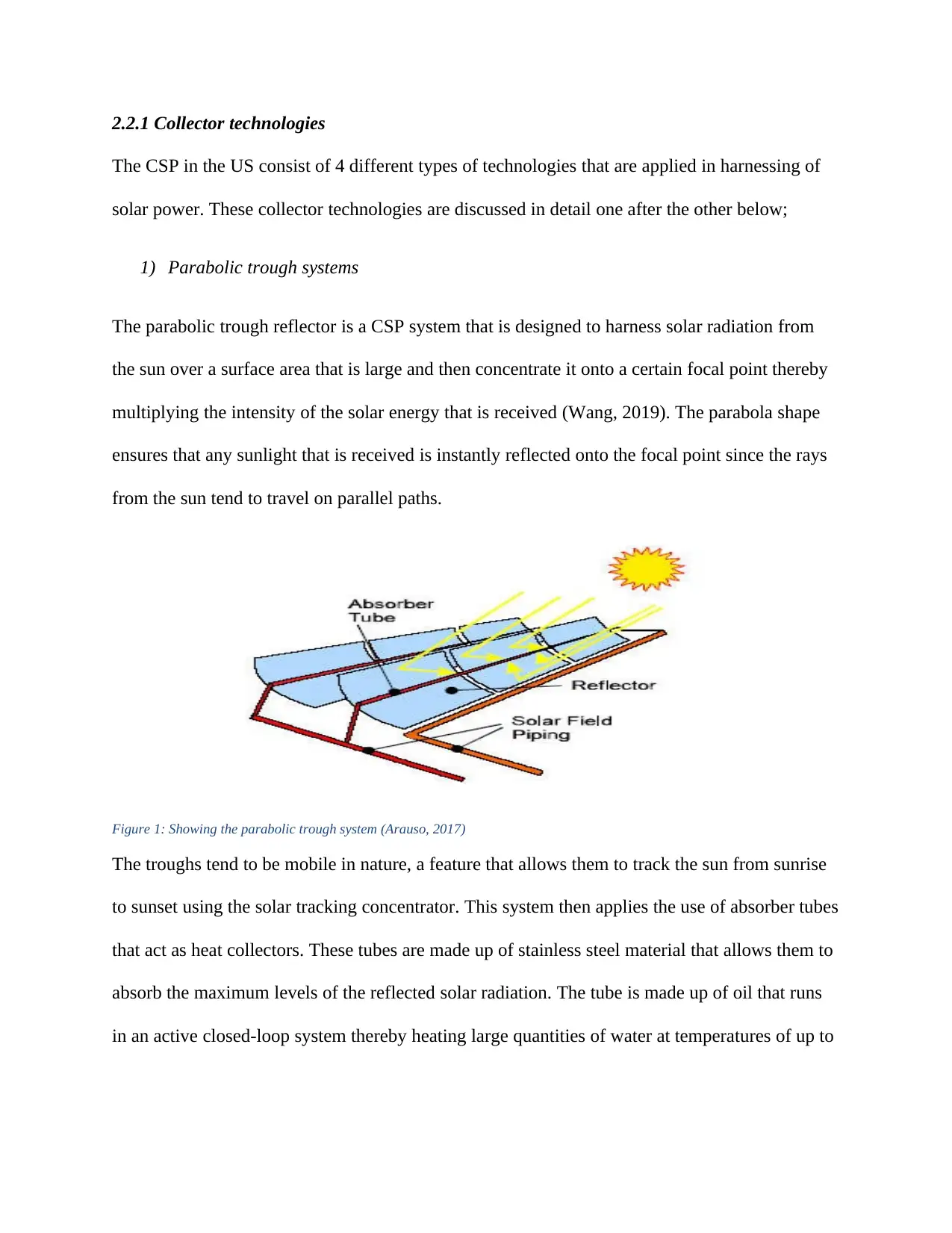
2.2.1 Collector technologies
The CSP in the US consist of 4 different types of technologies that are applied in harnessing of
solar power. These collector technologies are discussed in detail one after the other below;
1) Parabolic trough systems
The parabolic trough reflector is a CSP system that is designed to harness solar radiation from
the sun over a surface area that is large and then concentrate it onto a certain focal point thereby
multiplying the intensity of the solar energy that is received (Wang, 2019). The parabola shape
ensures that any sunlight that is received is instantly reflected onto the focal point since the rays
from the sun tend to travel on parallel paths.
Figure 1: Showing the parabolic trough system (Arauso, 2017)
The troughs tend to be mobile in nature, a feature that allows them to track the sun from sunrise
to sunset using the solar tracking concentrator. This system then applies the use of absorber tubes
that act as heat collectors. These tubes are made up of stainless steel material that allows them to
absorb the maximum levels of the reflected solar radiation. The tube is made up of oil that runs
in an active closed-loop system thereby heating large quantities of water at temperatures of up to
The CSP in the US consist of 4 different types of technologies that are applied in harnessing of
solar power. These collector technologies are discussed in detail one after the other below;
1) Parabolic trough systems
The parabolic trough reflector is a CSP system that is designed to harness solar radiation from
the sun over a surface area that is large and then concentrate it onto a certain focal point thereby
multiplying the intensity of the solar energy that is received (Wang, 2019). The parabola shape
ensures that any sunlight that is received is instantly reflected onto the focal point since the rays
from the sun tend to travel on parallel paths.
Figure 1: Showing the parabolic trough system (Arauso, 2017)
The troughs tend to be mobile in nature, a feature that allows them to track the sun from sunrise
to sunset using the solar tracking concentrator. This system then applies the use of absorber tubes
that act as heat collectors. These tubes are made up of stainless steel material that allows them to
absorb the maximum levels of the reflected solar radiation. The tube is made up of oil that runs
in an active closed-loop system thereby heating large quantities of water at temperatures of up to
Paraphrase This Document
Need a fresh take? Get an instant paraphrase of this document with our AI Paraphraser
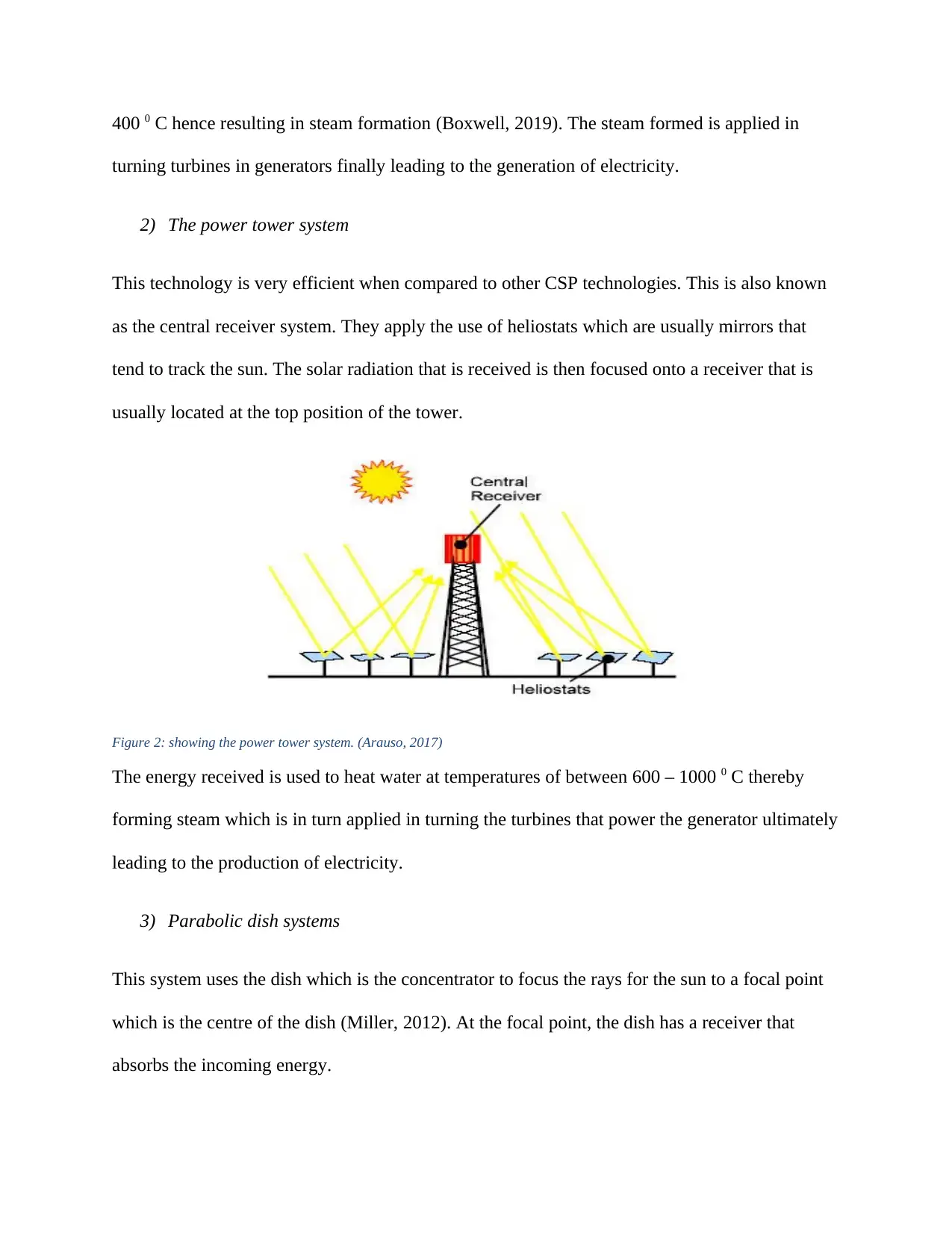
400 0 C hence resulting in steam formation (Boxwell, 2019). The steam formed is applied in
turning turbines in generators finally leading to the generation of electricity.
2) The power tower system
This technology is very efficient when compared to other CSP technologies. This is also known
as the central receiver system. They apply the use of heliostats which are usually mirrors that
tend to track the sun. The solar radiation that is received is then focused onto a receiver that is
usually located at the top position of the tower.
Figure 2: showing the power tower system. (Arauso, 2017)
The energy received is used to heat water at temperatures of between 600 – 1000 0 C thereby
forming steam which is in turn applied in turning the turbines that power the generator ultimately
leading to the production of electricity.
3) Parabolic dish systems
This system uses the dish which is the concentrator to focus the rays for the sun to a focal point
which is the centre of the dish (Miller, 2012). At the focal point, the dish has a receiver that
absorbs the incoming energy.
turning turbines in generators finally leading to the generation of electricity.
2) The power tower system
This technology is very efficient when compared to other CSP technologies. This is also known
as the central receiver system. They apply the use of heliostats which are usually mirrors that
tend to track the sun. The solar radiation that is received is then focused onto a receiver that is
usually located at the top position of the tower.
Figure 2: showing the power tower system. (Arauso, 2017)
The energy received is used to heat water at temperatures of between 600 – 1000 0 C thereby
forming steam which is in turn applied in turning the turbines that power the generator ultimately
leading to the production of electricity.
3) Parabolic dish systems
This system uses the dish which is the concentrator to focus the rays for the sun to a focal point
which is the centre of the dish (Miller, 2012). At the focal point, the dish has a receiver that
absorbs the incoming energy.
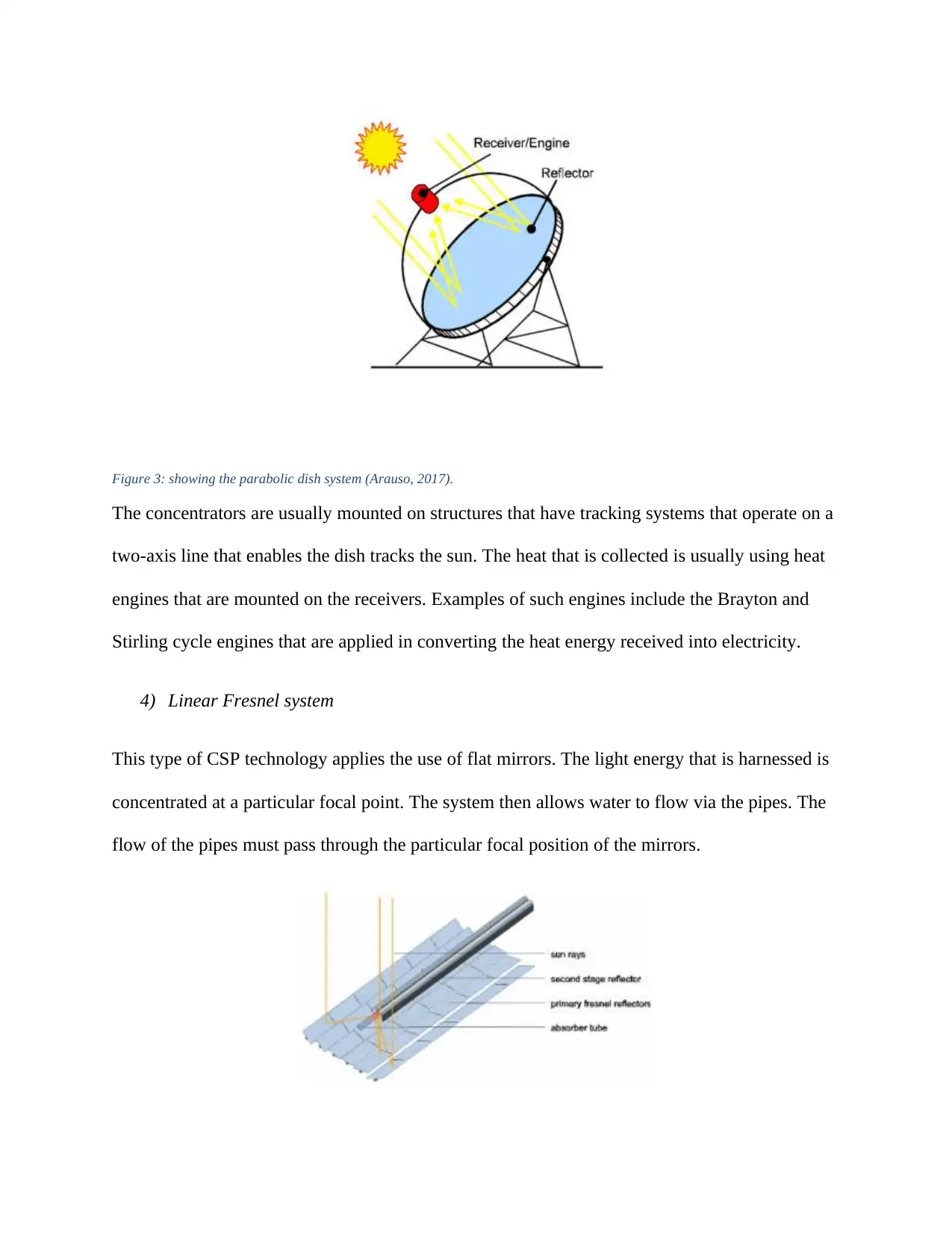
Figure 3: showing the parabolic dish system (Arauso, 2017).
The concentrators are usually mounted on structures that have tracking systems that operate on a
two-axis line that enables the dish tracks the sun. The heat that is collected is usually using heat
engines that are mounted on the receivers. Examples of such engines include the Brayton and
Stirling cycle engines that are applied in converting the heat energy received into electricity.
4) Linear Fresnel system
This type of CSP technology applies the use of flat mirrors. The light energy that is harnessed is
concentrated at a particular focal point. The system then allows water to flow via the pipes. The
flow of the pipes must pass through the particular focal position of the mirrors.
The concentrators are usually mounted on structures that have tracking systems that operate on a
two-axis line that enables the dish tracks the sun. The heat that is collected is usually using heat
engines that are mounted on the receivers. Examples of such engines include the Brayton and
Stirling cycle engines that are applied in converting the heat energy received into electricity.
4) Linear Fresnel system
This type of CSP technology applies the use of flat mirrors. The light energy that is harnessed is
concentrated at a particular focal point. The system then allows water to flow via the pipes. The
flow of the pipes must pass through the particular focal position of the mirrors.
⊘ This is a preview!⊘
Do you want full access?
Subscribe today to unlock all pages.

Trusted by 1+ million students worldwide
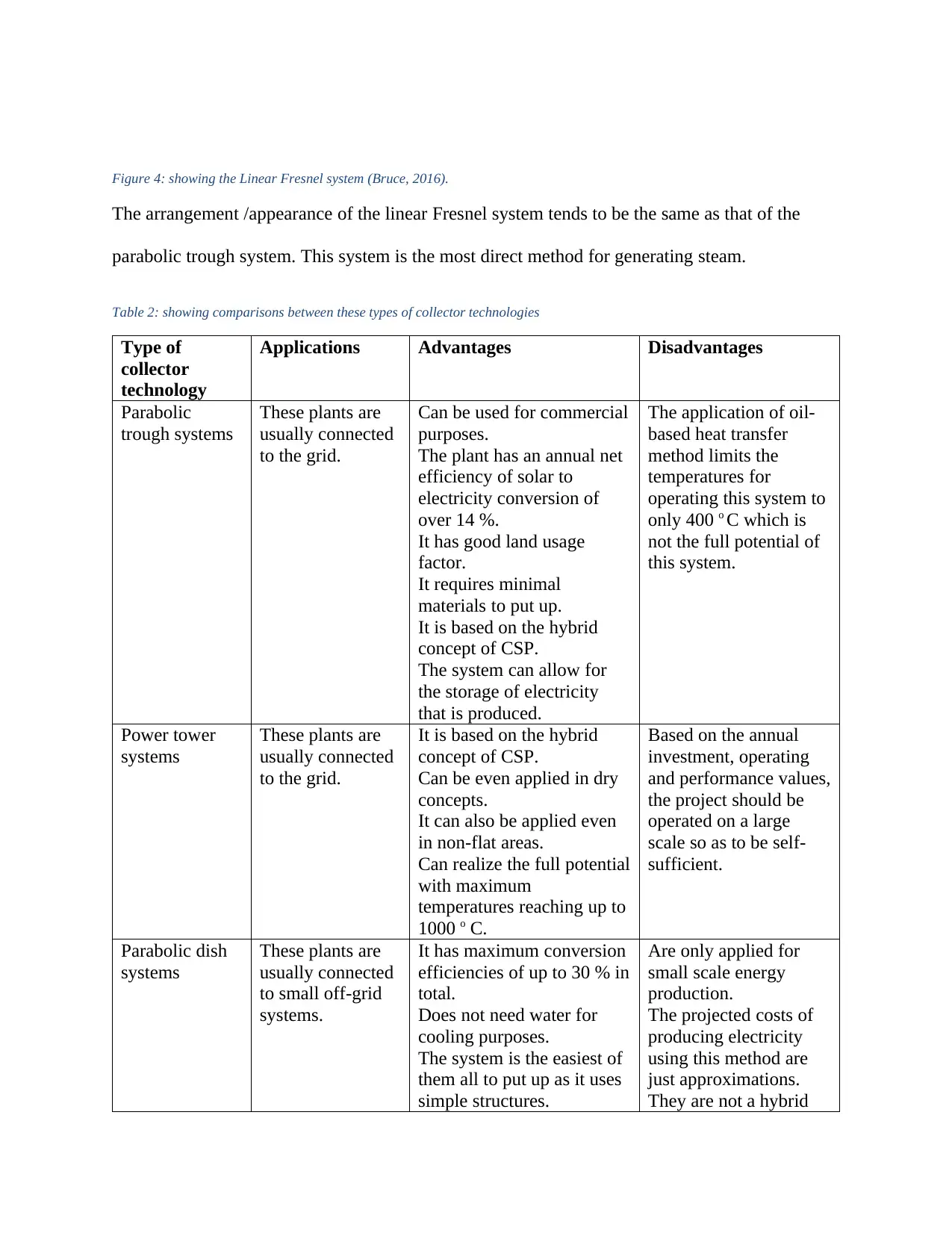
Figure 4: showing the Linear Fresnel system (Bruce, 2016).
The arrangement /appearance of the linear Fresnel system tends to be the same as that of the
parabolic trough system. This system is the most direct method for generating steam.
Table 2: showing comparisons between these types of collector technologies
Type of
collector
technology
Applications Advantages Disadvantages
Parabolic
trough systems
These plants are
usually connected
to the grid.
Can be used for commercial
purposes.
The plant has an annual net
efficiency of solar to
electricity conversion of
over 14 %.
It has good land usage
factor.
It requires minimal
materials to put up.
It is based on the hybrid
concept of CSP.
The system can allow for
the storage of electricity
that is produced.
The application of oil-
based heat transfer
method limits the
temperatures for
operating this system to
only 400 o C which is
not the full potential of
this system.
Power tower
systems
These plants are
usually connected
to the grid.
It is based on the hybrid
concept of CSP.
Can be even applied in dry
concepts.
It can also be applied even
in non-flat areas.
Can realize the full potential
with maximum
temperatures reaching up to
1000 o C.
Based on the annual
investment, operating
and performance values,
the project should be
operated on a large
scale so as to be self-
sufficient.
Parabolic dish
systems
These plants are
usually connected
to small off-grid
systems.
It has maximum conversion
efficiencies of up to 30 % in
total.
Does not need water for
cooling purposes.
The system is the easiest of
them all to put up as it uses
simple structures.
Are only applied for
small scale energy
production.
The projected costs of
producing electricity
using this method are
just approximations.
They are not a hybrid
The arrangement /appearance of the linear Fresnel system tends to be the same as that of the
parabolic trough system. This system is the most direct method for generating steam.
Table 2: showing comparisons between these types of collector technologies
Type of
collector
technology
Applications Advantages Disadvantages
Parabolic
trough systems
These plants are
usually connected
to the grid.
Can be used for commercial
purposes.
The plant has an annual net
efficiency of solar to
electricity conversion of
over 14 %.
It has good land usage
factor.
It requires minimal
materials to put up.
It is based on the hybrid
concept of CSP.
The system can allow for
the storage of electricity
that is produced.
The application of oil-
based heat transfer
method limits the
temperatures for
operating this system to
only 400 o C which is
not the full potential of
this system.
Power tower
systems
These plants are
usually connected
to the grid.
It is based on the hybrid
concept of CSP.
Can be even applied in dry
concepts.
It can also be applied even
in non-flat areas.
Can realize the full potential
with maximum
temperatures reaching up to
1000 o C.
Based on the annual
investment, operating
and performance values,
the project should be
operated on a large
scale so as to be self-
sufficient.
Parabolic dish
systems
These plants are
usually connected
to small off-grid
systems.
It has maximum conversion
efficiencies of up to 30 % in
total.
Does not need water for
cooling purposes.
The system is the easiest of
them all to put up as it uses
simple structures.
Are only applied for
small scale energy
production.
The projected costs of
producing electricity
using this method are
just approximations.
They are not a hybrid
Paraphrase This Document
Need a fresh take? Get an instant paraphrase of this document with our AI Paraphraser
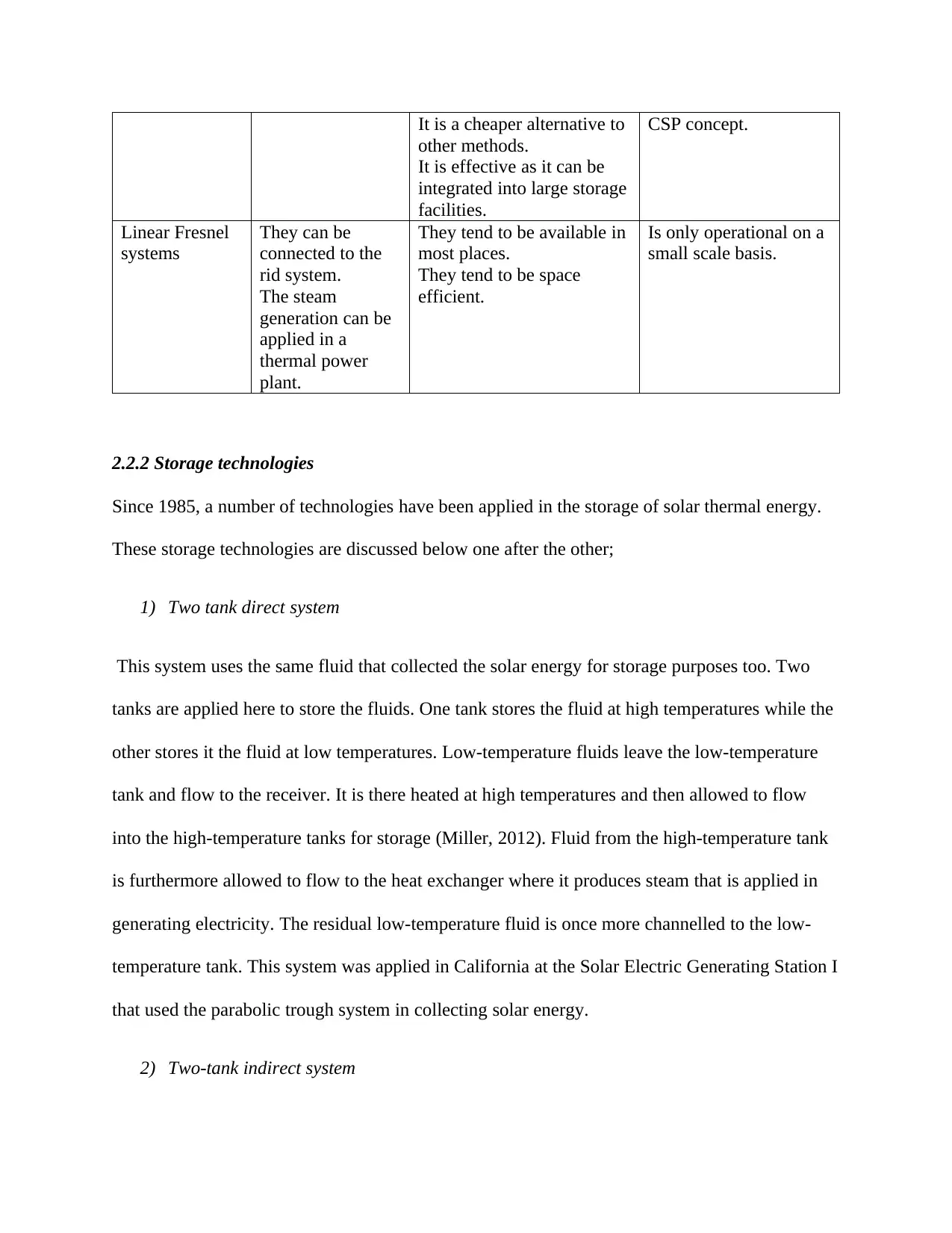
It is a cheaper alternative to
other methods.
It is effective as it can be
integrated into large storage
facilities.
CSP concept.
Linear Fresnel
systems
They can be
connected to the
rid system.
The steam
generation can be
applied in a
thermal power
plant.
They tend to be available in
most places.
They tend to be space
efficient.
Is only operational on a
small scale basis.
2.2.2 Storage technologies
Since 1985, a number of technologies have been applied in the storage of solar thermal energy.
These storage technologies are discussed below one after the other;
1) Two tank direct system
This system uses the same fluid that collected the solar energy for storage purposes too. Two
tanks are applied here to store the fluids. One tank stores the fluid at high temperatures while the
other stores it the fluid at low temperatures. Low-temperature fluids leave the low-temperature
tank and flow to the receiver. It is there heated at high temperatures and then allowed to flow
into the high-temperature tanks for storage (Miller, 2012). Fluid from the high-temperature tank
is furthermore allowed to flow to the heat exchanger where it produces steam that is applied in
generating electricity. The residual low-temperature fluid is once more channelled to the low-
temperature tank. This system was applied in California at the Solar Electric Generating Station I
that used the parabolic trough system in collecting solar energy.
2) Two-tank indirect system
other methods.
It is effective as it can be
integrated into large storage
facilities.
CSP concept.
Linear Fresnel
systems
They can be
connected to the
rid system.
The steam
generation can be
applied in a
thermal power
plant.
They tend to be available in
most places.
They tend to be space
efficient.
Is only operational on a
small scale basis.
2.2.2 Storage technologies
Since 1985, a number of technologies have been applied in the storage of solar thermal energy.
These storage technologies are discussed below one after the other;
1) Two tank direct system
This system uses the same fluid that collected the solar energy for storage purposes too. Two
tanks are applied here to store the fluids. One tank stores the fluid at high temperatures while the
other stores it the fluid at low temperatures. Low-temperature fluids leave the low-temperature
tank and flow to the receiver. It is there heated at high temperatures and then allowed to flow
into the high-temperature tanks for storage (Miller, 2012). Fluid from the high-temperature tank
is furthermore allowed to flow to the heat exchanger where it produces steam that is applied in
generating electricity. The residual low-temperature fluid is once more channelled to the low-
temperature tank. This system was applied in California at the Solar Electric Generating Station I
that used the parabolic trough system in collecting solar energy.
2) Two-tank indirect system
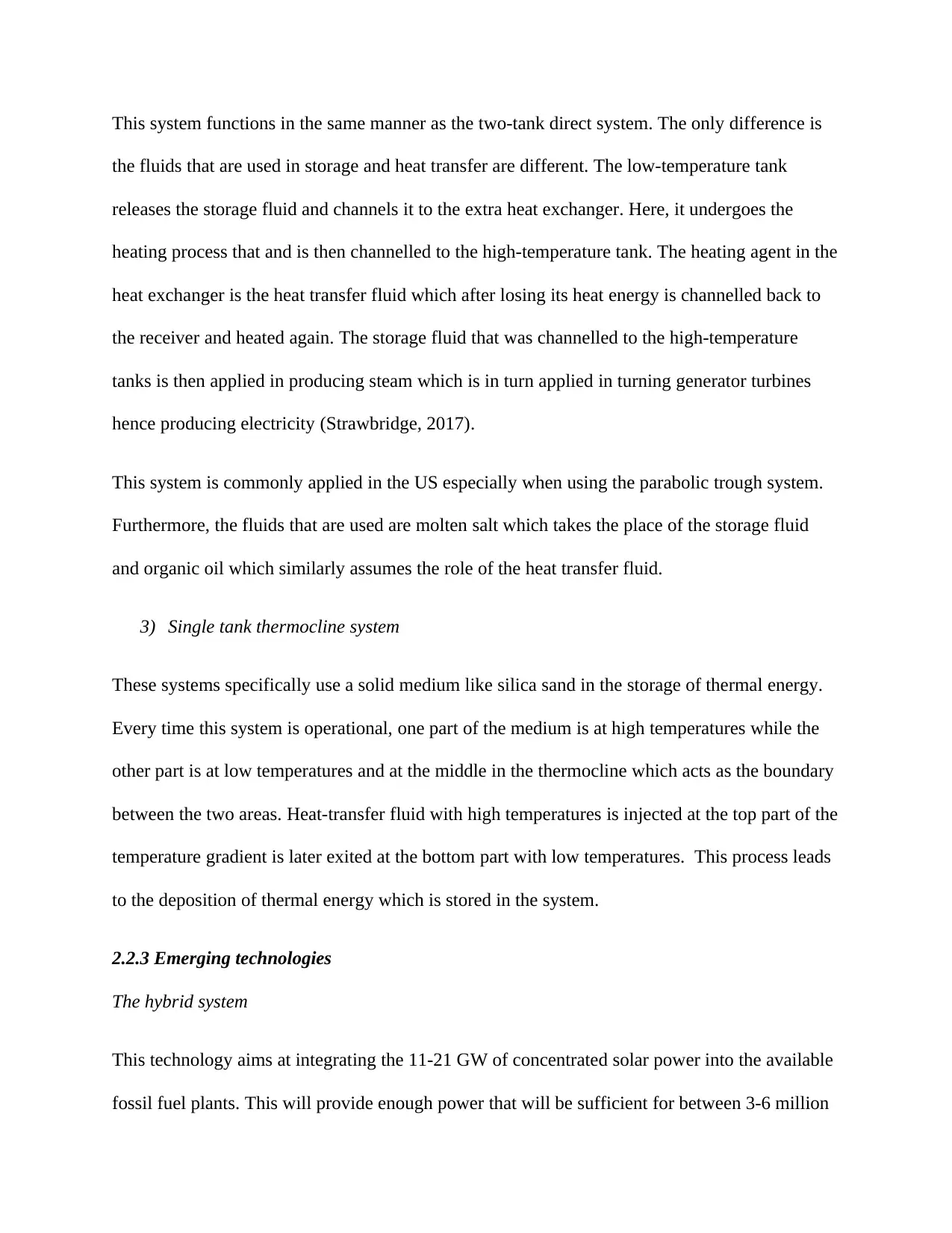
This system functions in the same manner as the two-tank direct system. The only difference is
the fluids that are used in storage and heat transfer are different. The low-temperature tank
releases the storage fluid and channels it to the extra heat exchanger. Here, it undergoes the
heating process that and is then channelled to the high-temperature tank. The heating agent in the
heat exchanger is the heat transfer fluid which after losing its heat energy is channelled back to
the receiver and heated again. The storage fluid that was channelled to the high-temperature
tanks is then applied in producing steam which is in turn applied in turning generator turbines
hence producing electricity (Strawbridge, 2017).
This system is commonly applied in the US especially when using the parabolic trough system.
Furthermore, the fluids that are used are molten salt which takes the place of the storage fluid
and organic oil which similarly assumes the role of the heat transfer fluid.
3) Single tank thermocline system
These systems specifically use a solid medium like silica sand in the storage of thermal energy.
Every time this system is operational, one part of the medium is at high temperatures while the
other part is at low temperatures and at the middle in the thermocline which acts as the boundary
between the two areas. Heat-transfer fluid with high temperatures is injected at the top part of the
temperature gradient is later exited at the bottom part with low temperatures. This process leads
to the deposition of thermal energy which is stored in the system.
2.2.3 Emerging technologies
The hybrid system
This technology aims at integrating the 11-21 GW of concentrated solar power into the available
fossil fuel plants. This will provide enough power that will be sufficient for between 3-6 million
the fluids that are used in storage and heat transfer are different. The low-temperature tank
releases the storage fluid and channels it to the extra heat exchanger. Here, it undergoes the
heating process that and is then channelled to the high-temperature tank. The heating agent in the
heat exchanger is the heat transfer fluid which after losing its heat energy is channelled back to
the receiver and heated again. The storage fluid that was channelled to the high-temperature
tanks is then applied in producing steam which is in turn applied in turning generator turbines
hence producing electricity (Strawbridge, 2017).
This system is commonly applied in the US especially when using the parabolic trough system.
Furthermore, the fluids that are used are molten salt which takes the place of the storage fluid
and organic oil which similarly assumes the role of the heat transfer fluid.
3) Single tank thermocline system
These systems specifically use a solid medium like silica sand in the storage of thermal energy.
Every time this system is operational, one part of the medium is at high temperatures while the
other part is at low temperatures and at the middle in the thermocline which acts as the boundary
between the two areas. Heat-transfer fluid with high temperatures is injected at the top part of the
temperature gradient is later exited at the bottom part with low temperatures. This process leads
to the deposition of thermal energy which is stored in the system.
2.2.3 Emerging technologies
The hybrid system
This technology aims at integrating the 11-21 GW of concentrated solar power into the available
fossil fuel plants. This will provide enough power that will be sufficient for between 3-6 million
⊘ This is a preview!⊘
Do you want full access?
Subscribe today to unlock all pages.

Trusted by 1+ million students worldwide
1 out of 19
Related Documents
Your All-in-One AI-Powered Toolkit for Academic Success.
+13062052269
info@desklib.com
Available 24*7 on WhatsApp / Email
![[object Object]](/_next/static/media/star-bottom.7253800d.svg)
Unlock your academic potential
Copyright © 2020–2025 A2Z Services. All Rights Reserved. Developed and managed by ZUCOL.




